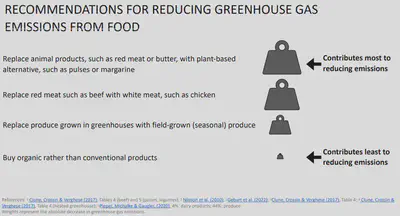Simple rules to reduce the climate impact of food
What is the boost?
Simple rules of thumb help people to understand how to effectively reduce the climate impact of consumer decisions. For example: “Replace red meat with white meat or plant-based proteins,” “Replace high-fat dairy products with plant-based alternatives,” or ”Buy seasonal.”

Which challenges does the boost tackle?
Collective dietary changes are a quick and effective way to reduce greenhouse gas emissions, but understanding how food choices link to climate change can be challenging for consumers: Carbon emissions of foods may vary across seasons; climate impact can be confounded with other sustainability challenges, such as pollution or biodiversity loss; and numbers on greenhouse gas emissions can be hard to comprehend.
How does it work?
Simple rules of thumb are easy to remember and can be applied across a range of different situations, such as grocery shopping, choosing a restaurant meal or evaluating policies addressing the climate impact of food. They provide consumers with alternative choices, rather than telling them what not to eat. Furthermore, they omit complex information.
Which competences does the boost foster?
Simple rules increase ‘carbon capability’, the competence to understand how to effectively reduce carbon emissions.
What is the evidence behind it?
People struggle to understand the climate impacts of food. Also, people use very few, simple but often ineffective rules for reducing their climate impact, such as “Buy organic”, “Buy local” or “Reduce packaging”.
Analyses from environmental sciences can help developing simple rules for reducing climate impact of food. They show that e.g., seasonal (field-grown) vegetables are associated with 0.47 kg CO2-eq/kg, compared to 2.81 kg CO2-eq/kg of vegetables grown in a heated greenhouse. Soybeans (0.58 kg CO2-eq/kg) which feed into tofu, fish (4.41 kg CO2-eq/kg) or chicken (4.12 kg CO2-eq/kg) have a lower impact, compared to red meat such as lamb (kg CO2-eq/kg 27.91) or beef (28.73 kg CO2-eq/kg).
Key reference
- Camilleri, A. R., Larrick, R. P., Hossain, S., & Patino-Echeverri, D. (2019). Consumers underestimate the emissions associated with food but are aided by labels. Nature Climate Change, 9(1), 53–58. https://doi.org/10.1038/s41558-018-0354-z
- Clune, S., Crossin, E., & Verghese, K. (2017). Systematic review of greenhouse gas emissions for different fresh food categories. Journal of Cleaner Production, 140, 766–783. https://doi.org/10.1016/j.jclepro.2016.04.082
- Hafenbrädl, S., Waeger, D., Marewski, J. N., & Gigerenzer, G. (2016). Applied decision making with fast-and-frugal heuristics. Journal of Applied Research in Memory and Cognition, 5(2), 215–231. https://doi.org/10.1016/j.jarmac.2016.04.011
- Ivanova, D., Barrett, J., Wiedenhofer, D., Macura, B., Callaghan, M., & Creutzig, F. (2020). Quantifying the potential for climate change mitigation of consumption options. In Environmental Research Letters, 15(9), Article 093001. https://doi.org/10.1088/1748-9326/ab8589
- Kause, A., Bruine de Bruin, W., Millward-Hopkins, J., & Olsson, H. (2019). Public perceptions of how to reduce carbon footprints of consumer food choices. Environmental Research Letters, 14(11), Article 114005. https://doi.org/10.1088/1748-9326/ab465d